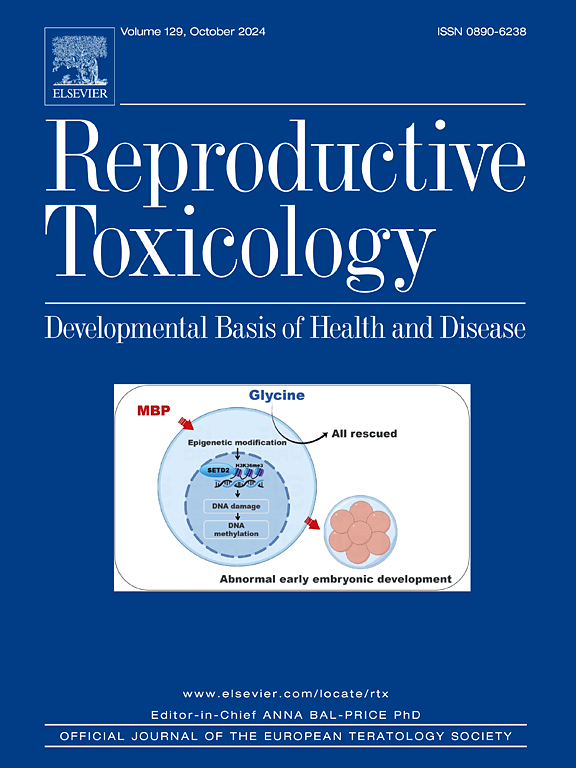Tattoo exposure and biomarkers of male fecundity: A cross-sectional study among young Danish males
IF 2.8
4区 医学
Q2 REPRODUCTIVE BIOLOGY
引用次数: 0
Abstract
Background
Tattoo inks are mixtures of organic and inorganic color pigments and having a tattoo may be adversely associated with biomarkers of male fecundity.
Objective
To examine the association between tattoo exposure and biomarkers of male fecundity.
Methods
Participants were young adult Danish males (aged 18–21 years) sampled from the Danish National Birth Cohort. Upon recruitment in 2017–2019, participants answered a comprehensive questionnaire including information on tattoo exposure and provided a semen and blood sample. We applied a negative binomial regression model to estimate percentage differences (95 % confidence intervals [CI]) in semen characteristics, testicular volume, and reproductive hormone levels between tattooed and non-tattooed participants.
Results
Among the 1045 participants included in this study, 174 (17 %) had at least one tattoo and most tattooed participants (84 %) had tattoo(s) in only black color. About half (53 %) had one tattoo, 21 % had two tattoos, and 26 % had three or more tattoos. We observed no association between either number or color scheme of tattoo(s) relative to semen characteristics or reproductive hormone levels. Having a tattoo was associated with 6 % (95 % CI: 0, 12) larger testicular volume, but since testicular volume was measured by the participants themselves, this finding may be due to differential misclassification bias. Across all outcomes the crude and adjusted models were comparable.
Conclusion
Overall, we found no support for adverse associations between tattoo exposure and biomarkers of male fecundity, but studies with more details on tattoo exposure and longer follow-up of participants are needed before firm conclusions can be drawn.
纹身暴露和男性生殖力的生物标志物:丹麦年轻男性的横断面研究。
背景:纹身油墨是有机和无机颜料的混合物,纹身可能与男性繁殖力的生物标志物不利相关。目的:探讨纹身暴露与男性生殖力生物标志物的关系。方法:参与者是来自丹麦国家出生队列的年轻成年丹麦男性(18-21岁)。在2017-2019年的招募中,参与者回答了一份全面的问卷,包括纹身暴露的信息,并提供了精液和血液样本。我们应用负二项回归模型来估计未纹身和纹身参与者在精液特征、睾丸体积和生殖激素水平方面的百分比差异(95%置信区间[CI])。结果:在这项研究的1045名参与者中,174人(17%)至少有一个纹身,大多数纹身参与者(84%)只有黑色纹身。大约一半(53%)的人有一个纹身,21%有两个纹身,26%有三个或更多纹身。我们观察到纹身的数量或颜色方案与精液特征或生殖激素水平之间没有关联。纹身与睾丸体积增大6% (95% CI: 0.12)有关,但由于睾丸体积是由参与者自己测量的,因此这一发现可能是由于差异误分类偏差。在所有结果中,粗模型和调整模型具有可比性。结论:总的来说,我们没有发现纹身暴露与男性生育能力的生物标志物之间存在不利关联的证据,但在得出确切的结论之前,需要对纹身暴露进行更详细的研究,并对参与者进行更长的随访。
本文章由计算机程序翻译,如有差异,请以英文原文为准。
求助全文
约1分钟内获得全文
求助全文
来源期刊

Reproductive toxicology
生物-毒理学
CiteScore
6.50
自引率
3.00%
发文量
131
审稿时长
45 days
期刊介绍:
Drawing from a large number of disciplines, Reproductive Toxicology publishes timely, original research on the influence of chemical and physical agents on reproduction. Written by and for obstetricians, pediatricians, embryologists, teratologists, geneticists, toxicologists, andrologists, and others interested in detecting potential reproductive hazards, the journal is a forum for communication among researchers and practitioners. Articles focus on the application of in vitro, animal and clinical research to the practice of clinical medicine.
All aspects of reproduction are within the scope of Reproductive Toxicology, including the formation and maturation of male and female gametes, sexual function, the events surrounding the fusion of gametes and the development of the fertilized ovum, nourishment and transport of the conceptus within the genital tract, implantation, embryogenesis, intrauterine growth, placentation and placental function, parturition, lactation and neonatal survival. Adverse reproductive effects in males will be considered as significant as adverse effects occurring in females. To provide a balanced presentation of approaches, equal emphasis will be given to clinical and animal or in vitro work. Typical end points that will be studied by contributors include infertility, sexual dysfunction, spontaneous abortion, malformations, abnormal histogenesis, stillbirth, intrauterine growth retardation, prematurity, behavioral abnormalities, and perinatal mortality.
 求助内容:
求助内容: 应助结果提醒方式:
应助结果提醒方式:


